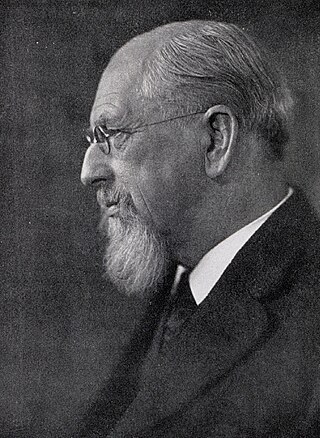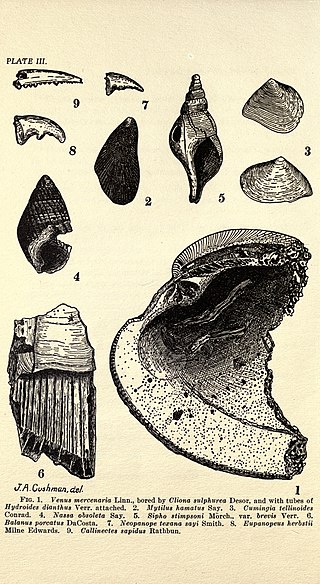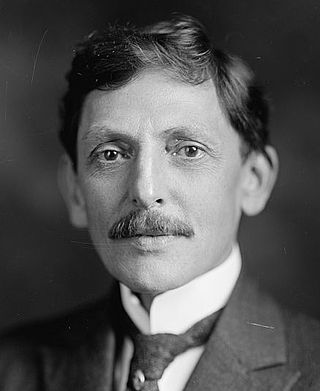Related Research Articles

The Smithsonian Institution, or simply the Smithsonian, is a group of museums, education and research centers, the largest such complex in the world, created by the U.S. government "for the increase and diffusion of knowledge." Founded on August 10, 1846, it operates as a trust instrumentality and is not formally a part of any of the three branches of the federal government. The institution is named after its founding donor, British scientist James Smithson. It was originally organized as the United States National Museum, but that name ceased to exist administratively in 1967.

Charles Doolittle Walcott was an American paleontologist, administrator of the Smithsonian Institution from 1907 to 1927, and director of the United States Geological Survey. He is famous for his discovery in 1909 of well-preserved fossils, including some of the oldest soft-part imprints, in the Burgess Shale of British Columbia, Canada.

Othniel Charles Marsh was an American professor of paleontology at Yale College and president of the National Academy of Sciences. He was one of the preeminent scientists in the field of paleontology. Among his legacies are the discovery or description of dozens of new species and theories on the origins of birds.

Spencer Fullerton Baird was an American naturalist, ornithologist, ichthyologist, herpetologist, and museum curator. Baird was the first curator to be named at the Smithsonian Institution. He eventually served as assistant Secretary of the Smithsonian from 1850 to 1878, and as Secretary from 1878 until 1887. He was dedicated to expanding the natural history collections of the Smithsonian which he increased from 6,000 specimens in 1850 to over 2 million by the time of his death. He also served as the U.S. Commissioner of Fish and Fisheries from 1871 to 1887 and published over 1,000 works during his lifetime.

John Reed Swanton was an American anthropologist, folklorist, and linguist who worked with Native American peoples throughout the United States. Swanton achieved recognition in the fields of ethnology and ethnohistory. He is particularly noted for his work with indigenous peoples of the Southeast and Pacific Northwest.

William Healey Dall was an American naturalist, a prominent malacologist, and one of the earliest scientific explorers of interior Alaska. He described many mollusks of the Pacific Northwest of North America, and was for many years America's preeminent authority on living and fossil mollusks.

Clinton Hart Merriam was an American zoologist, mammalogist, ornithologist, entomologist, ecologist, ethnographer, geographer, naturalist and physician. He was commonly known as the 'father of mammalogy', a branch of zoology referring to the study of mammals.

Ephraim George Squier, usually cited as E. G. Squier, was an American archaeologist, history writer, painter and newspaper editor.

Joseph Augustine Cushman was an American micropaleontologist and academic. He specialized in the study of marine protozoans (foraminifera) and became the foremost foraminiferologist of the first half of the twentieth century, developing to a "world-famous system of discovering petroleum deposits". He also was a founding father of Kappa Delta Phi fraternity.

Matthew Williams Stirling was an American ethnologist, archaeologist and later an administrator at several scientific institutions in the field. He is best known for his discoveries relating to the Olmec civilization. Much of his work was done with his "wife and constant collaborator" of 42 years Marion Stirling.

Silvio A. Bedini was an American historian, specialising in early scientific instruments. He was Historian Emeritus of the Smithsonian Institution, where he served on the professional staff for twenty-five years, retiring in 1987.

Smithsonian Libraries and Archives is an institutional archives and library system comprising 21 branch libraries serving the various Smithsonian Institution museums and research centers. The Libraries and Archives serve Smithsonian Institution staff as well as the scholarly community and general public with information and reference support. Its collections number nearly 3 million volumes including 50,000 rare books and manuscripts.

The Essex Institute (1848–1992) in Salem, Massachusetts, was "a literary, historical and scientific society." It maintained a museum, library, historic houses; arranged educational programs; and issued numerous scholarly publications. In 1992 the institute merged with the Peabody Museum of Salem to form the Peabody Essex Museum.
The Biological Society of Washington is a worldwide acting scientific organisation established on 3 December 1880 in Washington, D.C., United States. The original purpose was "to encourage the study of the Biological Sciences and to hold meetings at which papers shall be read and discussed." The current primary function is "the furtherance of taxonomic study and the diffusion of taxonomic knowledge."

Paul Bartsch was an American malacologist and carcinologist. He was named the last of those belonging to the "Descriptive Age of Malacology".
The Smithsonian's Museum Conservation Institute (MCI) aims to be the center for specialized conservation and technical collection research for all of the Smithsonian museums and collections. MCI's staff combine state-of-the-art instrumentation and scientific techniques with the knowledge of materials and the history of technology to provide technical research studies and interpretation of art, as well as historical and anthropological objects, to improve the conservation and collections storage capabilities at the Smithsonian. For the majority of the Smithsonian collections, MCI is the only Smithsonian resource for technical studies and analyses.

William Schaus was an American entomologist who became known for his major contribution to the knowledge and description of new species of the Neotropical Lepidoptera.
Heritage Preservation was an American non-profit organization. Its mission was to preserve the nation's heritage for future generations through innovative leadership, education, and programs. As of June 30, 2015 the organization was dissolved by its board. Several of its programs and resources have been absorbed by the Foundation for Advancement in Conservation. "Records that document the history and activities of Heritage Preservation from its very beginnings as the National Conservation Advisory Council and the National Institute for the Conservation of Cultural Property", including an archive of its website, were accessioned by and are made accessible by the Smithsonian Institution Archives.
Thomas M. Lera is an American philatelist who was the Winton M. Blount Research Chair at the Smithsonian National Postal Museum until 2021. He is also an expert on the preservation and the conservation of bats and caves and has been a vice-president of the National Speleological Society.
Pearl Lee Boone was an invertebrate zoologist at the Smithsonian's National Museum of Natural History. She was one of the more infamous carcinologists of her time, as her career was fraught with claims of incompetence and disagreements about the veracity of her work in identifications.
References
- 1 2 3 4 5 6 7 History of Scholarly Publishing Archived 2009-04-11 at the Library of Congress Web Archives, Smithsonian Institution .
- ↑ Originally Smithsonian Studies in History and Technology.